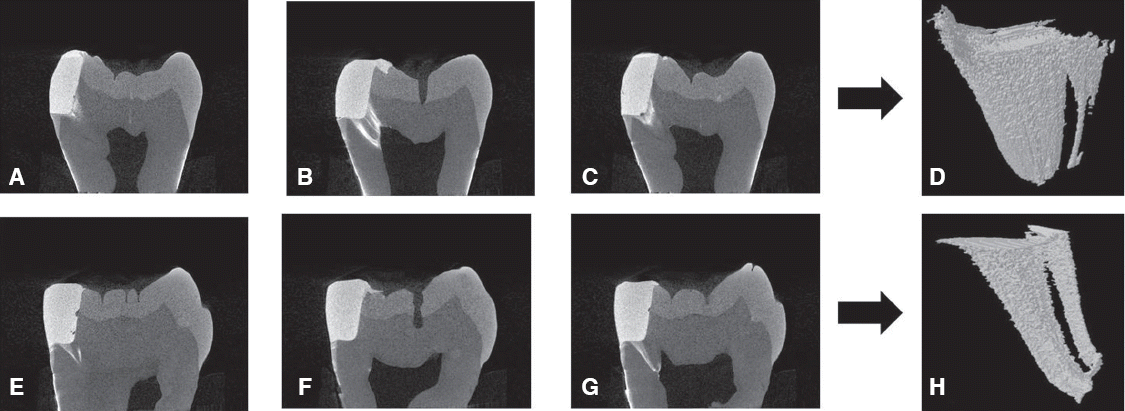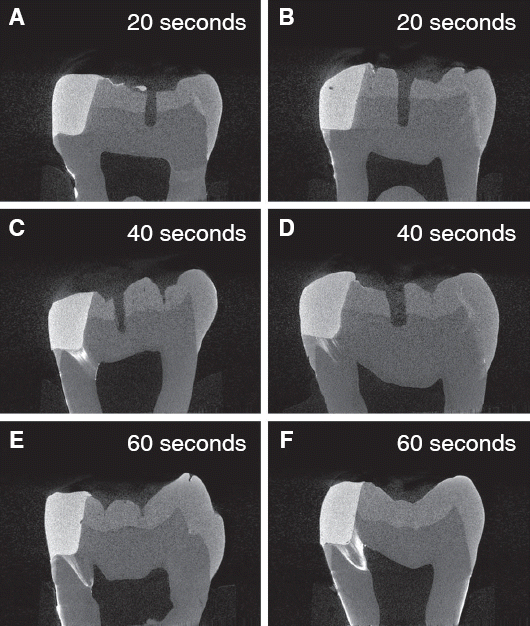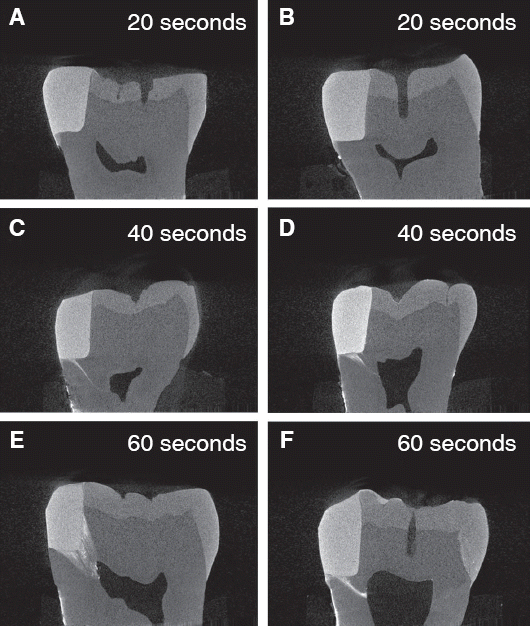1. Mahmound SH, Al-Wakeel Eel S. Marginal adaptation of ormocer-, silorane-, and methacrylate-based composite restorative systems bonded to dentin cavities after water storage. Quintessence Int. 2011; 42:e131–9.
2. Czasch P, Ilie N. In vitro comparison of mechanical properties and degree of cure of bulk fill composites. Clin Oral Investig. 2013; 17:227–35. DOI:
10.1007/s00784-012-0702-8. PMID:
22411261.
3. Ilie N, Hickel R. Investigations on a methacrylatebased flowable composite based on the SDR technology. Dent Mater. 2011; 27:348–55. DOI:
10.1016/j.dental.2010.11.014. PMID:
21194743.
4. El-Damanhoury H, Platt J. Polymerization shrinkage stress kinetic and related properties of bulk-fill resin composites. Oper Dent. 2014; 39:374–82. DOI:
10.2341/13-017-L. PMID:
23865582.
5. Moorthy A, Hogg CH, Dowling AH, Grufferty BF, Benetti AR, Fleming GJ. Cuspal deflection and microleakage in premolar teeth restored with bulkfill flowable resin-based composite base materials. J Dent. 2012; 40:500–5. DOI:
10.1016/j.jdent.2012.02.015. PMID:
22390980.
6. El-Safty S, Silikas N, Watts DC. Creep deformation of restorative resin-composites intended for bulkfill placement. Dent Mater. 2012; 28:928–35. DOI:
10.1016/j.dental.2012.04.038. PMID:
22656273.
7. Naoum SJ, Ellakwa A, Morgan L, White K, Martin FE, Lee IB. Polymerization profile analysis of resin composite dental restorative materials in real time. J Dent. 2012; 40:64–70. DOI:
10.1016/j.jdent.2011.10.006. PMID:
22044773.
10. Ilie N, Keßler A, Durner J. Influence of various irradiation processes on the mechanical properties and polymerization kinetics of bulk-fill resin based composites. J Dent. 2013; 41:695–702. DOI:
10.1016/j.jdent.2013.05.008. PMID:
23707645.
11. Flury S, Hayoz S, Peutzfeldt A, Hüsler J, Lussi A. Depth of cure of resin composites: is the ISO 4049 method suitable for bulk fill materials? Dent Mater. 2012; 28:521–8. DOI:
10.1016/j.dental.2012.02.002. PMID:
22391146.
12. Abbas G, Fleming GJ, Harrington E, Shortall AC, Burke FJ. Cuspal movement and microleakage in premolar teeth restored with a packable composite cured in bulk or in increments. J Dent. 2003; 31:437–44. DOI:
10.1016/S0300-5712(02)00121-5.
13. Tiba A, Zeller GG, Estrich CG, Hong A. A laboratory evaluation of bulk-fill versus traditional multiincrement- fill resin-based composites. J Am Dent Assoc. 2013; 144:1182–3. DOI:
10.14219/jada.archive.2013.0040. PMID:
25946430.
16. Price RB, Ehrnford L, Andreous P, Felix CA. Comparison of quartz-tungsten-halogen, light-emitting diode, and plasma arc curing lights. J Adhes Dent. 2003; 5:193–207. PMID:
14621241.
17. Rueggeberg F. Contemporary issues in photocuring. Compend Contin Educ Dent Suppl. 1999; 25:S4–S15. PMID:
11908395.
18. Visvanathan A, Ilie N, Hickel R, Kunzelmann KH. The influence of curing times and light curing methods on the polymerization shrinkage stress of a shrinkage-optimized composite with hybrid-type prepolymer fillers. Dent Mater. 2007; 23:777–84. DOI:
10.1016/j.dental.2006.06.019. PMID:
16914193.
19. Dewaele M, Asmussen E, Devaux J, Leloup G. Class II restorations: influence of a liner with rubbery qualities on the occurrence and size of cervical gaps. Eur J Oral Sci. 2006; 114:535–541. DOI:
10.1111/j.1600-0722.2006.00407.x. PMID:
17184237.
20. Feilzer AJ, Dooren LH, de GEE AJ, Davidson CL. Influence of light intensity on polymerization shrinkage and integrity of restoration-cavity interface. Eur J Oral Sci. 1995; 103:322–6. DOI:
10.1111/j.1600-0722.1995.tb00033.x. PMID:
8521124.
21. Atai M, Watts DC. A new kinetic model for the photopolymerization shrinkage-strain of dental composites and resin monomers. Dent Mater. 2006; 22:785–91. DOI:
10.1016/j.dental.2006.02.009. PMID:
16540163.
22. Pongprueksa P, Kuphasuk W, Senawongse P. The elastic moduli across various types of resin/dentin interfaces. Dent Mater. 2008; 24:1102–6. DOI:
10.1016/j.dental.2007.12.008. PMID:
18304626.
23. Bouschlicher MR, Rueggeberg FA, Boyer DB. Effect of stepped light intensity on polymerization force and conversion in a photoactivated composite. J Esthet Dent. 2000; 12:23–32. DOI:
10.1111/j.1708-8240.2000.tb00242.x. PMID:
11323830.
25. Ilie N, Bucuta S, Draenert M. Bulk-fill resin-based composites: an in vitro assessment of their mechanical performance. Oper Dent. 2013; 38:618–25. DOI:
10.2341/12-395-L. PMID:
23570302.
26. Li X, Pongprueksa P, Van Meerbeek B, De Munck J. Curing profile of bulk-fill resin-based composites. J Dent. 2015; 43:664–72. DOI:
10.1016/j.jdent.2015.01.002. PMID:
25597265.
27. Garcia D, Yaman P, Dennison J, Neiva G. Polymerization shrinkage and depth of cure of bulk fill flowable composite resins. Oper Dent. 2014; 39:441–8. DOI:
10.2341/12-484-L. PMID:
24304339.
28. Benetti AR, Havndrup-Pedersen C, Honoré D, Pedersen MK, Pallesen U. Bulk-fill resin composites: polymerization contraction, depth of cure, and gap formation. Oper Dent. 2015; 40:190–200. DOI:
10.2341/13-324-L. PMID:
25216940.
29. Jang JH, Park SH, Hwang IN. Polymerization shrinkage and depth of cure of bulk-fill resin composites and highly filled flowable resin. Oper Dent. 2015; 40:172–80. DOI:
10.2341/13-307-L. PMID:
25136904.
30. Eden E, Topaloglu-AK A, Cuijpers V, Frenchen JE. Micro-CT for measuring marginal leakage of Class II resin composite restorations in primary molars prepared in vivo. Am J Dent. 2008; 21:393–7. PMID:
19146134.
31. Zhao XY, Li SB, Gu LJ, Li Y. Detection of marginal leakage of Class V restorations in vitro by microcomputed tomography. Oper Dent. 2014; 39:174–80. DOI:
10.2341/12-182-L. PMID:
23802643.
32. Chen X, Cuijpers VM, Fan MW, Frencken JE. Validation of micro-CT against the section method regarding the assessment of marginal leakage of sealant. Aust Dent J. 2012; 57:196–9. DOI:
10.1111/j.1834-7819.2012.01687.x. PMID:
22624761.
33. Raskin A, Tassery H, D’Hoore W, Gonthier S, Vreven J, Degrange M, Déjou J. Influence of the number of sections on reliability of in vitro microleakage evaluations. Am J Dent. 2003; 16:207–10. PMID:
12967077.
34. Abdalla AI, Davidson CL. Comparison of the marginal integrity of in vivo and in vitro Class II composite restorations. J Dent. 1993; 21:158–62. DOI:
10.1016/0300-5712(93)90026-M.






 PDF
PDF Citation
Citation Print
Print





 XML Download
XML Download